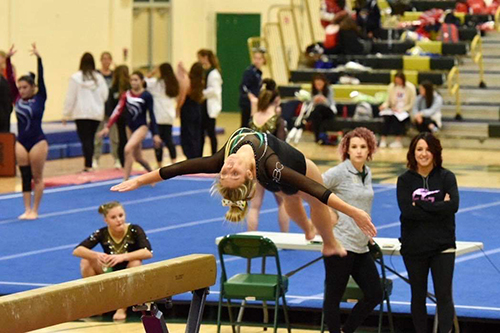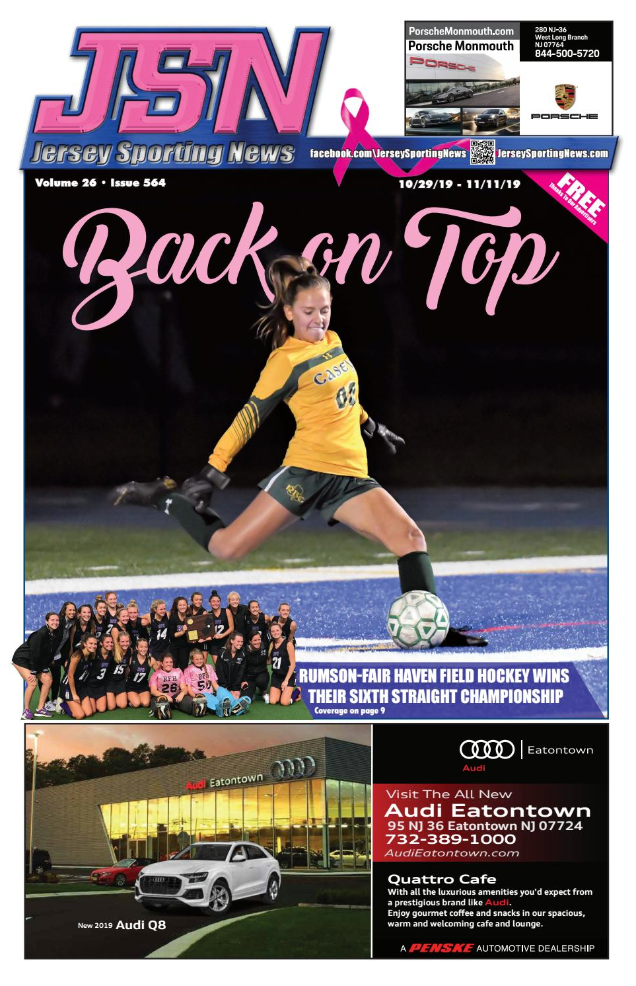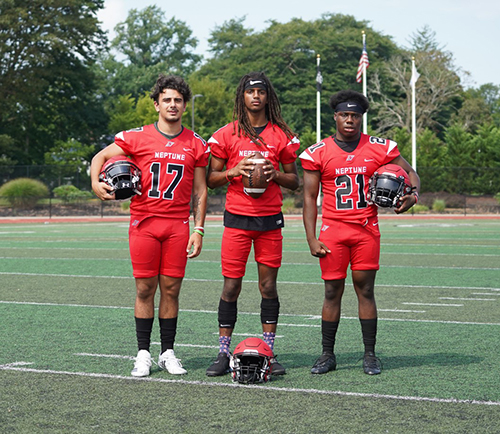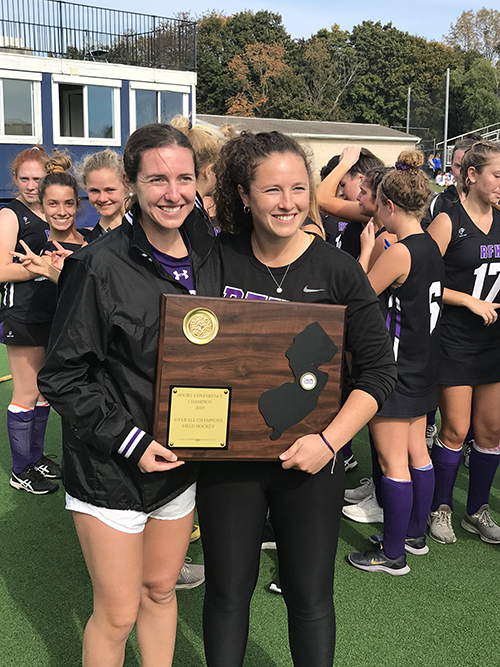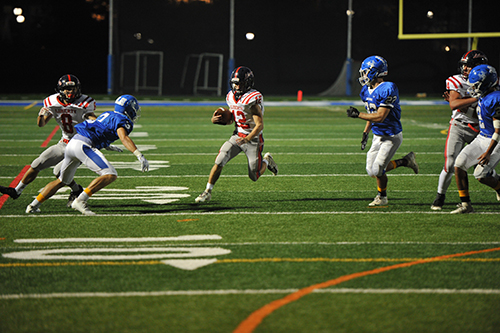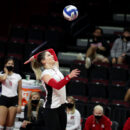.jpg) No Obstacle Can Keep This RBC Gymnast from Competing
No Obstacle Can Keep This RBC Gymnast from Competing
By Robert Solomon
RED BANK –
A young girl is introduced to gymnastics at an early age. She takes to the sport and decides that she wants to compete “like the girls on TV.” She works hard, becomes an accomplished gymnast and competes “like the girls on TV.” A surprise diagnosis turns her gymnastics world upside down. Tragedy turns to triumph as she overcomes her situation and returns to the sport she loves. This is the story of Mackenzie Haar, a remarkable girl and a member of the Red Bank Catholic gymnastics team.
Mackenzie began her gymnastics journey at All-American Gymnastics at age 6. She went once a week and fell in love with the sport. She moved to ACE Gymnastics when she was 7 years old and immediately became a member of its gymnastics team. She competed at ACE through 7th grade before moving onto Head over Heels Gymnastics.
As a student at Ocean Township Intermediate School, she was so committed to her gymnastics and her team that arrangements were made for her to leave school early to get to practice on time. This dedication led to an improvement of her skills and enabled her to move from level to level, peaking at level 9. In 2016 she competed in her first level 9 competition, The Liberty Cup. Mackenzie’s hard work and practice paid off as she walked away winning first place all around.
The following winter she completed in the Christmas on the Chesapeake Meet and finished fourth all around – a great accomplishment in a meet with numerous highly skilled competitors. She felt her goal of competing on the Red Bank Catholic team was well within her sights.
In February 2016, the intermediate school nurse notified Mackenzie’s parents that she noticed Mackenzie had scoliosis during the school scoliosis screening. They took Mackenzie to the doctor in April and were told that her scoliosis was minor and shouldn’t be a problem, explained her mother, Kristen Haar.
The following January, Mackenzie just didn’t feel right in practice.
“She felt like she was going to hurt herself performing some skills she was being asked to perform,” said Kristen. Her parents didn’t think it was anything out of the ordinary for a teenage girl to go through a period of self-doubt. They thought it was just a bump in the road. The performance of her skills went down. Her favorite events of bars and floor exercise also suffered.
They became concerned as Mackenzie’s practices were regressing. “Her ability to perform her skills slowly went from good to bad to nonexistent, within a two-month period,” according to Kristen.
Mackenzie went for her track physical at school in February 2017 and the nurse again contacted her parents. They were aware of her scoliosis and already had scheduled an appointment with her doctor in March. At this appointment the doctor revealed that her scoliosis had gotten much worse.
“I really didn’t completely understand what was going on and didn’t realize the extent of the diagnosis,” Mackenzie explained. Something had to be done and unfortunately surgery was necessary. Traditionally, spinal fusion is the method to correct scoliosis.
“This type of surgery would limit her from touching her toes and we were worried about future limitations,” stated Kristen. It would put an end to Mackenzie’s gymnastics career and was unacceptable. After many hours of research, Kristen found an alternate surgery. She explained that she stumbled onto tethering surgery.
Unlike spinal fusion where curved vertebrae are fused together and thus limiting spinal movement, tethering connects a rope-like device with screws to the vertebrae allowing the growth of bones to help in the straightening of the spine, allowing more movement of the spine. At the time of Mackenzie’s surgery, tethering was an experimental procedure but has since been approved by the FDA.
“We got turned away a lot,” Kristen said. She explained that very few doctors were performing the experimental surgery. That was an obstacle they had to overcome, she said. “We found a doctor in Princeton and one in New York that would perform the surgery. We also found one in Missouri as a possible back-up,” she explained. Cost and Mackenzie’s eligibility were the other obstacles that had to be overcome. “Insurance would pay for the hospital stay but the procedure was not covered,” Kristen said. Most hospitals required a hefty deposit. “We would have gotten the money,” exclaimed Kristen, but that turned out to be unnecessary.
.jpg) Shriners Hospital in Philadelphia offered to pay for the surgery. Kristen was nervous and prayed Mackenzie would be a candidate for Shriners. Tethering usually has an age range of 8-15 years old and Mackenzie was pushing the upper limit. The doctors also take into account the possibility of the spine being able to show continued, significant growth, Kristen explained. Mackenzie was eligible and she had her surgery in June 2017, a year after winning all around in the Liberty Cup.
Shriners Hospital in Philadelphia offered to pay for the surgery. Kristen was nervous and prayed Mackenzie would be a candidate for Shriners. Tethering usually has an age range of 8-15 years old and Mackenzie was pushing the upper limit. The doctors also take into account the possibility of the spine being able to show continued, significant growth, Kristen explained. Mackenzie was eligible and she had her surgery in June 2017, a year after winning all around in the Liberty Cup. Mackenzie’s surgery was successful and her spinal curve angle (Cobb Angle) was reduced initially from 48 degrees to 32 degrees.
“We were happy with the results,” Kristen stated. The Cobb Angle eventually settled at 26 degrees, which is considered moderate and acceptable. Amazingly Mackenzie was able to walk for her 8th grade graduation a short eight days after surgery.
Mackenzie’s immediate quality of life was not changed by the surgery, although she didn’t have the pain in her back that she was experiencing before the surgery. Kristen explained that the surgery prevented the continuing of the curving of Mackenzie’s spine which typically increases approximately two degrees a year. It also avoided future complications she might have incurred and of course it allowed her to continue to participate in gymnastics.
The recovery time for tethering is roughly six weeks. Kristen explained that there is no specific rehabilitation for tethering but Mackenzie went to Elite Physical Therapy to strengthen her muscles. She returned to the gym in August. If she had spinal fusion surgery, the recovery time would have been about one year and gymnastics would have not even been a consideration.
Mackenzie joined the Red Bank Catholic gymnastics team as a freshman in September 2017. “It was pretty cool she got back so quickly,” Kristen said. However, Mackenzie was not the same gymnast as she was pre-surgery. Kristen explained that Mackenzie was limited in what she could do. There will always be a concern with hard landings and some tumbling. Her doctor was conservative but not overly so. He told her what she couldn’t do, explained Kristen. This limited Mackenzie’s ability to compete.
These limitations did not deter Mackenzie. She just “tried to assess where she was” with her skills, Kristen explained. Initially Mackenzie stayed off the bars and vault and avoided tumbling on the beam. After her six-month check-up, her doctor allowed her to try bars and vault. Mackenzie chose not to vault and due to a burning sensation she felt when she tumbled on the bars, she avoided that as well.
The goal Mackenzie set for herself was simple, but not easy. She wanted to be on the team as a contributing member. The sport of gymnastics cooperated. A gymnastics meet consists of four events – bars, beam, vault and floor. In each of these events there is a range of skills a gymnast can perform. Each gymnast on a team is not required to compete in all four events. When a gymnast does compete, she does not have to perform all the available skills to be successful and contribute to the team.
Tumbling and hard landings were not the only limitations for Mackenzie. She could not learn new skills due to a safety factor. Anytime you learn a new skill there is a greater chance of injury. Any compression of Mackenzie’s spine was a risk. Spotting Mackenzie was also a concern. Having to depend on someone else for Mackenzie’s safety was difficult and it is unfair to put that added pressure on a spotter, Kristen explained.
Mackenzie was able to overcome these limitations by focusing on the skills and components she was able to perform. “She has to be clean and safe with the skills and components she can do,” said Kristen. “She has to focus on making what she can do better. She has to do the best she could do although it is not always the highest difficulty.” Even with her limited skills, “she does well enough to qualify and help the team,” Kristen said with pride.
It seemed as if Mackenzie had found her comfort zone and had adjusted well. She has pain from time to time which gymnastics will exacerbate, Kristen explained. “The fear doesn’t end,” said Kristen. Mackenzie went to a sports orthopedic for reassurance. They were told that the scoliosis looked stable but her spine was curved. Mackenzie gauges how far she can push herself. “She’s good at it,” Kristen said. “She even has the ability to change her routine mid-performance if she feels the need.”
“Mackenzie loves being on the high school team. She has fun but just can’t do everything,” Kristen said. Her teammates have been great with helping when they can. They are all good friends and show mutual support for each other. “The gymnastics community is tight,” Kristen explained.
Mackenzie’s Red Bank Catholic gymnastics coaches have been great also, noted Kristen. Being a coach herself Kristen explained, “I think it is hard as a coach to understand when to push and when not to push an athlete. Seeing an athlete performing in practice or a meet and feeling that she could do better, while not factoring in injuries or limitations, is difficult.”
Mackenzie appreciates all the help and support everyone afforded her. She was especially appreciative of her family. “After the surgery they stepped back from gymnastics and allowed me to make the decision to return,” Mackenzie explained. “Everyone (her teammates) treated me like I was normal, but they were concerned about my back.”
Her teammates were also quick to get her ice when needed. “My coaches were really good,” she continued. She noted how her ACE coach JJ would push her knowing that she was OK.
The culmination of all her hard work is evident. Mackenzie qualified for the Shore Conference championships all three years she has competed. Kristen also feels that Mackenzie has grown a lot during this entire experience. “It was very humbling for her after Shore Conference championships. She was just happy to be there,” said Kristen. “She has learned to appreciate being part of a team and the sport versus focusing on winning.”
Initially Mackenzie was reluctant to talk about her condition and ordeal, noted Kristen. “She never wanted to talk about it,” she said. “Mackenzie acted like it didn’t exist.” Kristen said she felt that Mackenzie needed “to talk about it to own it.”
Mackenzie said that sometimes it is still hard to talk about it. “When it was over I didn’t think it was a big deal,” she explained.
The staff at Shriners Hospital encouraged Mackenzie to talk about it to other patients so they could look up to her for inspiration. Mackenzie explained that it felt cool to talk to the kids at Shriners Hospital who are going through the same situation she did. She likes to let them know that everything is going to be fine.
Mackenzie is planning to compete during her senior year. When asked if Mackenzie was planning on competing in college, Kristen said they talked about it and she probably won’t. “We talked about Acrobatics and Tumbling,” stated Kristen. Mackenzie would have to be lifted by another person and they felt it was too risky, she explained. “She cannot rely on someone else to catch her,” Kristen added. College cheerleading has the same concerns. Kristen mentioned that there is a possibility of college club gymnastics, but that is also a long shot.
Nursing is a field Mackenzie has been considering studying in college according to Kristen. “She really liked her nurses at Shriners Hospital,” Kristen said. That was a contributing factor in Mackenzie’s interest in nursing.
“All the nurses were so nice and always there. I would want to do that for someone else,” explained Mackenzie.
Kristen knows that sometimes the tether doesn’t hold. “But the doctor feel it should not be a problem for Mackenzie,” she said. “There does not seem to be a correlation between activity and failure,” she continued. They don’t know what will happen with the tether as Mackenzie gets older, as there is very little data available about how the tether responds as a person ages.
Mackenzie’s next doctor’s appointment is June 2020. Hopefully with another good report she will be able to continue on her gymnastics journey and compete for her fourth straight high school season.
Latest posts by admin (see all)
- 2023 JSN Awards Finalists Announced - December 18, 2023
- Sunil Sunder Raj Recaps Day One of State Football Finals With OnNJ (VIDEO) - November 27, 2023
- Mental Health and Exercise: Finding Balance in New Jersey's Fast-Paced Life - November 27, 2023

